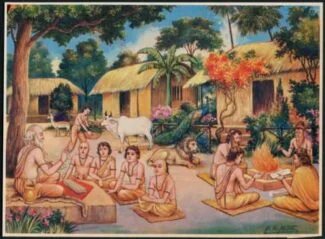~ Vaishnavi, Ridhima, Bargavi
Gurukul system of education is the most ancient teaching-learning process which was followed and propagated during the 19th century and before. Students are required to stay at the Gurukul along with the teacher till they do not complete their education. Every Gurukul aims to develop a holistic education system where the students are taught ethic, values and morals along with the curriculum. The system that existed during the Vedic age tries to inculcate values of humanity, love and to create the practice of self-discipline in every student’s life. The shishyas while learning involves household chores to experience an independent lifestyle while helping others with whom they share the Gurukul.
India’s teaching practices can be traced back to the 3rd Century BC where the teachers were known as “Gurus” and the students were referred to as “Shishyas”. References to these terms were made in various Vedas and Upanishads. Various archaeological pieces of evidence also reveal the existence of these establishments, especially near Hindu temples. These institutions were known to create, preserve and transmit the power of knowledge from one entity to another. Knowledge at that period was quite different from what we consider it to be now.
It involved subjects such as philosophy, martial arts, music and painting. The rank of a Guru was considered to be higher than that of the shishya’s parents, making him the ultimate power of knowledge and education. These pupils were expected to spend 12 years of their life at the Guru’s residence and in return, the Guru was obliged to teach them everything that he knew. In short, the success of the pupil-led to the success of the teacher, thus making the education system highly efficient and reliable.
Qualities of Gurus
- Knowledge of the sacred scriptures,
- Not having the urge to give into personal desires,
- Being the best among the knowers of Brahman,
- Being calm,
- Having passion like that of the fire after it has consumed all of its fuel.
Merits
The Gurukul system is widely accepted due to its feature which focuses on the overall development of students. The teacher-student interaction is increased as they live along with each other, spending most of the day together. The classrooms set amidst forests develop the attitude to protect and serve nature in the minds of the shishyas. Guru being the influential figure teaches every important aspect and gets the chance to correct the student whenever they notice a bad trait or behaviour. The pressure on students is not a burden, unlike the modern education system that sets standards to qualify as the best student. The Gurukul also preaches the practical aspect of every incident and does not depend upon theories thus giving the students real-life examples and a chance to learn from their errors. Even though many thinkers and latest ideas might have oppositions regarding the concept of Gurukul, it really is something that adds plenty of quality aspects to a student’s life.
Relevance in the Present Situation
Gurukul’s are not just a source of discipline but also a way to embark a journey towards a more balanced and fulfilled life. On the contrary, some people think that the Gurukul System is quite uncanny and unstructured concept because the students are devoid from a structured curriculum. Nevertheless, it has been noticed by the present-day educationalists that the ancient Indian approach of teaching should be ingrained in today’s educational system. The implementation of those value system is quintessential because it envisions to hone or develop concentration while at the same hand enhancing the development of the brain. However, in the modern-day educational system, the result is given so much importance that the students end up cramming things rather than understanding them practically. This archaic system ensures development in terms of a well-rounded holistic manner that enshrines values such as empathy, optimism, self-reliance, strong moral beliefs etc. In the present time and age, rote learning and bookish knowledge systems are nothing but the tools of time and henceforth in order to get rid of them, it is crucial to bring our roots back into this age of modernity. In the era of rank-based system, the revitalization of value-based or value- added system will not only ensure holistic growth but will also encourage and boost the uniqueness of each individual student.
Why the relevance of the Gurukul System is being underscored?
Good Teacher-Student Relationship
Students Become More Attentive
Students Gain More of Self-Awareness
Names of Few Schools that still follow the gurukul system:
- MIT Vishwashanti Gurukul
- Premanjali Bal Gurukul
III. Dr. S. Radhakrishnan Bal Gurukul
- Nirmala Matha Bal Gurukul
- Sreelekshmi Bal Gurukul
Must Read: Gurukul and Montessori Education System





